Line assistant BMW 5 SERIES 2013 F10 Owner's Manual
[x] Cancel search | Manufacturer: BMW, Model Year: 2013, Model line: 5 SERIES, Model: BMW 5 SERIES 2013 F10Pages: 273, PDF Size: 6.63 MB
Page 17 of 273
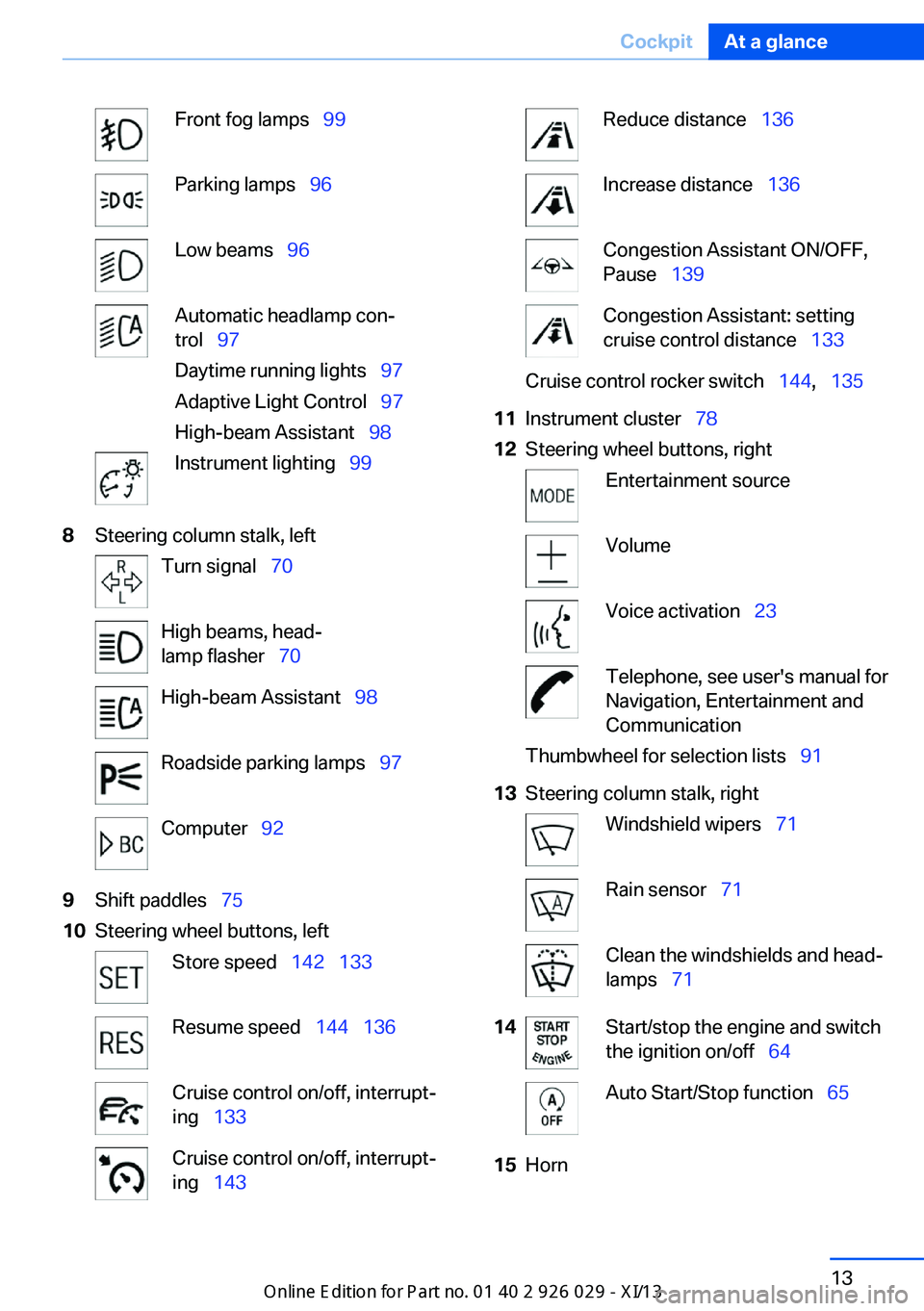
Front fog lamps‚Äā‚ÄÖ99Parking lamps‚Äā‚ÄÖ96Low beams‚Äā‚ÄÖ96Automatic headlamp con‚Äź
trol‚Äā‚ÄÖ 97
Daytime running lights‚Äā‚ÄÖ 97
Adaptive Light Control‚Äā‚ÄÖ 97
High-beam Assistant‚Äā‚ÄÖ 98Instrument lighting‚Äā‚ÄÖ998Steering column stalk, leftTurn signal‚Äā‚ÄÖ70High beams, head‚Äź
lamp flasher‚Äā‚ÄÖ 70High-beam Assistant‚Äā‚ÄÖ 98Roadside parking lamps‚Äā‚ÄÖ 97Computer‚Äā‚ÄÖ929Shift paddles‚Äā‚ÄÖ 7510Steering wheel buttons, leftStore speed‚Äā‚ÄÖ142‚Äā‚ÄÖ133Resume speed‚Äā‚ÄÖ 144‚Äā‚ÄÖ136Cruise control on/off, interrupt‚Äź
ing‚Äā‚ÄÖ 133Cruise control on/off, interrupt‚Äź
ing‚Äā‚ÄÖ 143Reduce distance‚Äā‚ÄÖ 136Increase distance‚Äā‚ÄÖ 136Congestion Assistant ON/OFF,
Pause‚Äā‚ÄÖ 139Congestion Assistant: setting
cruise control distance‚Äā‚ÄÖ 133Cruise control rocker switch‚Äā‚ÄÖ 144,‚Äā‚ÄÖ13511Instrument cluster‚Äā‚ÄÖ 7812Steering wheel buttons, rightEntertainment sourceVolumeVoice activation‚Äā‚ÄÖ23Telephone, see user's manual for
Navigation, Entertainment and
CommunicationThumbwheel for selection lists‚Äā‚ÄÖ 9113Steering column stalk, rightWindshield wipers‚Äā‚ÄÖ71Rain sensor‚Äā‚ÄÖ71Clean the windshields and head‚Äź
lamps‚Äā‚ÄÖ 7114Start/stop the engine and switch
the ignition on/off‚Äā‚ÄÖ 64Auto Start/Stop function‚Äā‚ÄÖ 6515HornSeite 13CockpitAt a glance13
Online Edition for Part no. 01 40 2 911 177 - VI/13
Page 18 of 273
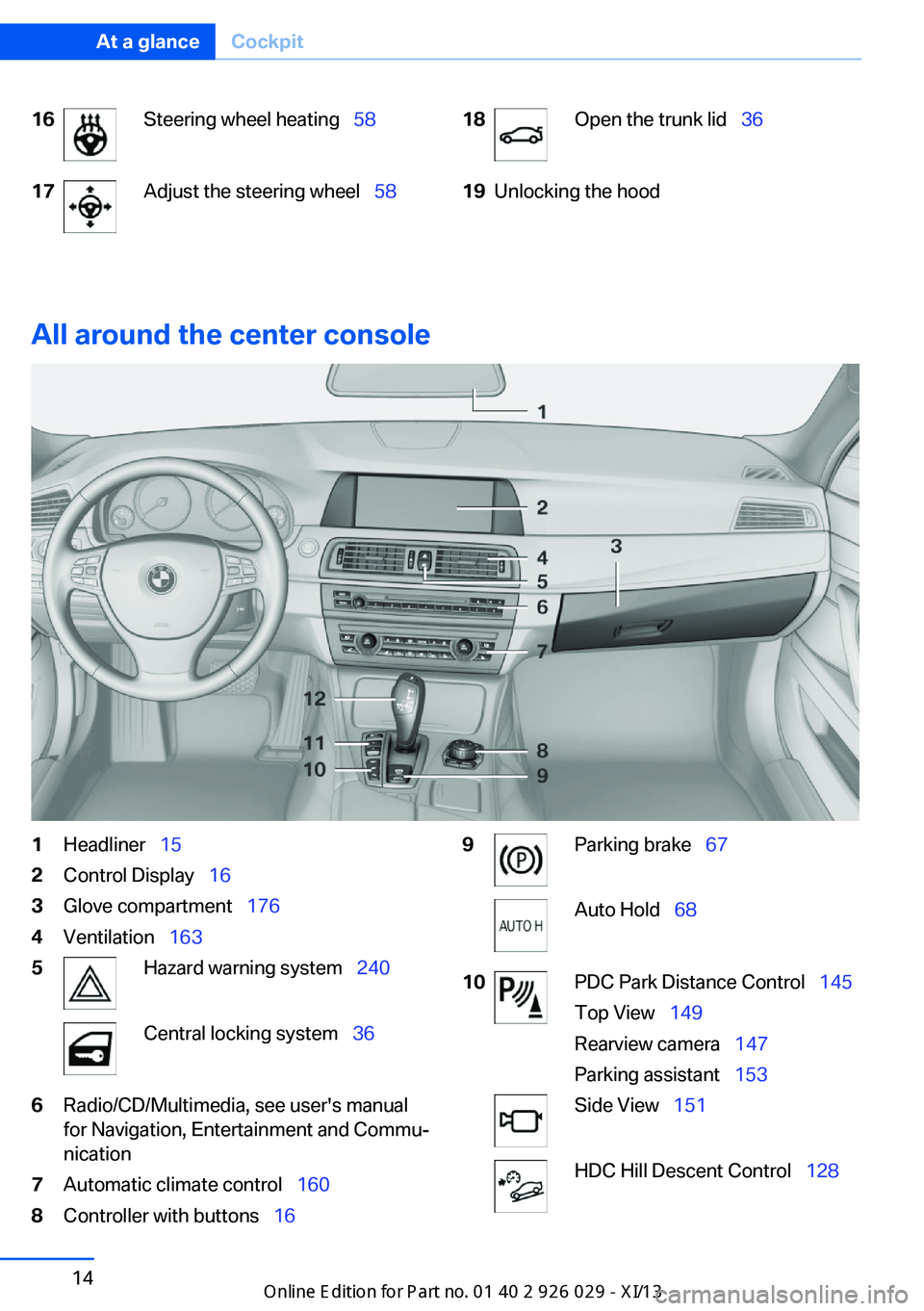
16Steering wheel heating‚Äā‚ÄÖ5817Adjust the steering wheel‚Äā‚ÄÖ 5818Open the trunk lid‚Äā‚ÄÖ3619Unlocking the hood
All around the center console
1Headliner‚Äā‚ÄÖ152Control Display‚Äā‚ÄÖ 163Glove compartment‚Äā‚ÄÖ 1764Ventilation‚Äā‚ÄÖ1635Hazard warning system‚Äā‚ÄÖ 240Central locking system‚Äā‚ÄÖ366Radio/CD/Multimedia, see user's manual
for Navigation, Entertainment and Commu‚Äź
nication7Automatic climate control‚Äā‚ÄÖ 1608Controller with buttons‚Äā‚ÄÖ169Parking brake‚Äā‚ÄÖ67Auto Hold‚Äā‚ÄÖ6810PDC Park Distance Control‚Äā‚ÄÖ 145
Top View‚Äā‚ÄÖ 149
Rearview camera‚Äā‚ÄÖ 147
Parking assistant‚Äā‚ÄÖ 153Side View‚Äā‚ÄÖ151HDC Hill Descent Control‚Äā‚ÄÖ 128Seite 14At a glanceCockpit14
Online Edition for Part no. 01 40 2 911 177 - VI/13
Page 70 of 273
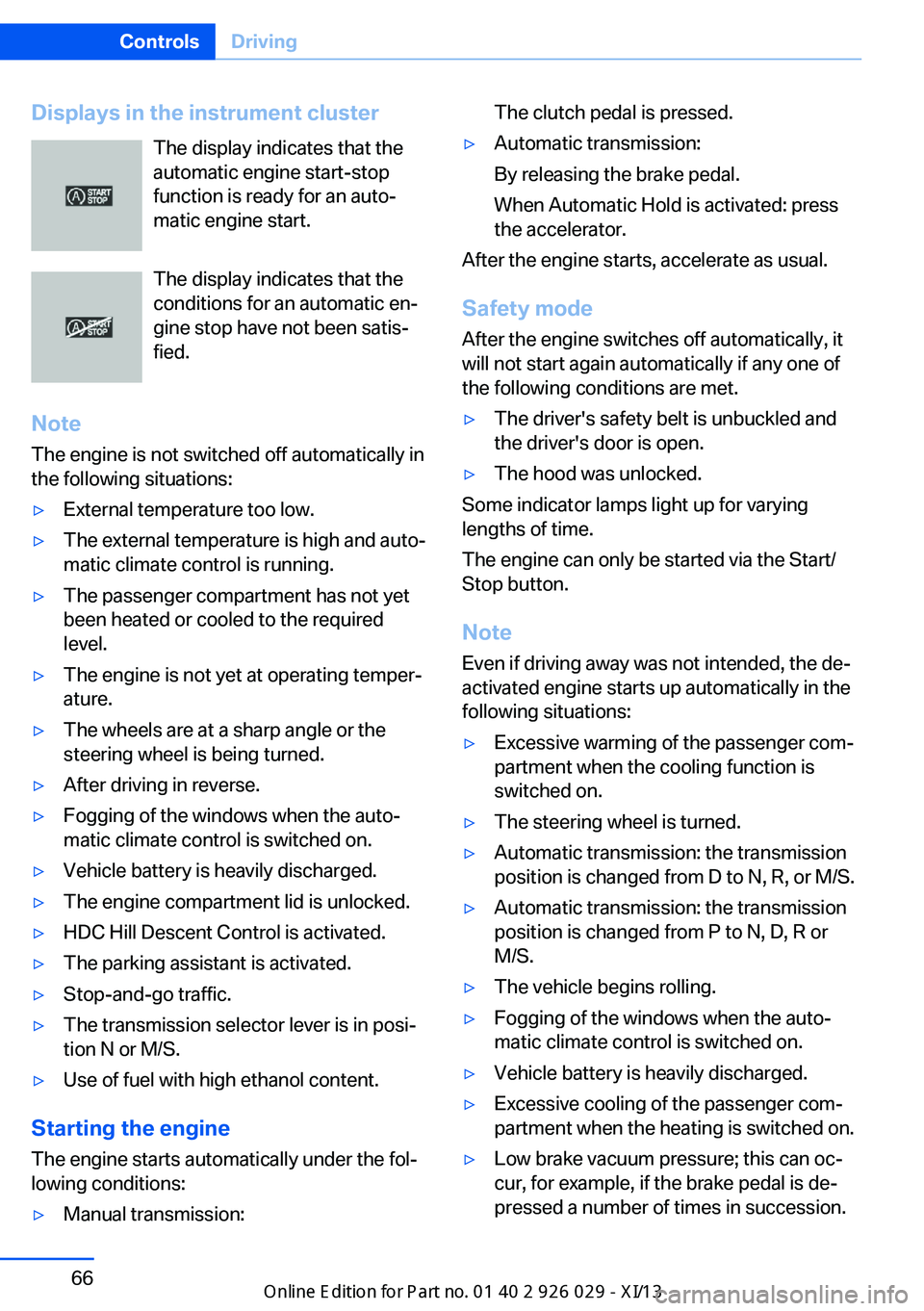
Displays in the instrument clusterThe display indicates that the
automatic engine start-stop
function is ready for an auto‚Äź
matic engine start.
The display indicates that the
conditions for an automatic en‚Äź
gine stop have not been satis‚Äź
fied.
Note The engine is not switched off automatically in
the following situations:‚Ė∑External temperature too low.‚Ė∑The external temperature is high and auto‚Äź
matic climate control is running.‚Ė∑The passenger compartment has not yet
been heated or cooled to the required
level.‚Ė∑The engine is not yet at operating temper‚Äź
ature.‚Ė∑The wheels are at a sharp angle or the
steering wheel is being turned.‚Ė∑After driving in reverse.‚Ė∑Fogging of the windows when the auto‚Äź
matic climate control is switched on.‚Ė∑Vehicle battery is heavily discharged.‚Ė∑The engine compartment lid is unlocked.‚Ė∑HDC Hill Descent Control is activated.‚Ė∑The parking assistant is activated.‚Ė∑Stop-and-go traffic.‚Ė∑The transmission selector lever is in posi‚Äź
tion N or M/S.‚Ė∑Use of fuel with high ethanol content.
Starting the engine
The engine starts automatically under the fol‚Äź
lowing conditions:
‚Ė∑Manual transmission:The clutch pedal is pressed.‚Ė∑Automatic transmission:
By releasing the brake pedal.
When Automatic Hold is activated: press
the accelerator.
After the engine starts, accelerate as usual.
Safety mode
After the engine switches off automatically, it
will not start again automatically if any one of
the following conditions are met.
‚Ė∑The driver's safety belt is unbuckled and
the driver's door is open.‚Ė∑The hood was unlocked.
Some indicator lamps light up for varying
lengths of time.
The engine can only be started via the Start/
Stop button.
Note Even if driving away was not intended, the de‚Äź
activated engine starts up automatically in the
following situations:
‚Ė∑Excessive warming of the passenger com‚Äź
partment when the cooling function is
switched on.‚Ė∑The steering wheel is turned.‚Ė∑Automatic transmission: the transmission
position is changed from D to N, R, or M/S.‚Ė∑Automatic transmission: the transmission
position is changed from P to N, D, R or
M/S.‚Ė∑The vehicle begins rolling.‚Ė∑Fogging of the windows when the auto‚Äź
matic climate control is switched on.‚Ė∑Vehicle battery is heavily discharged.‚Ė∑Excessive cooling of the passenger com‚Äź
partment when the heating is switched on.‚Ė∑Low brake vacuum pressure; this can oc‚Äź
cur, for example, if the brake pedal is de‚Äź
pressed a number of times in succession.Seite 66ControlsDriving66
Online Edition for Part no. 01 40 2 911 177 - VI/13
Page 87 of 273
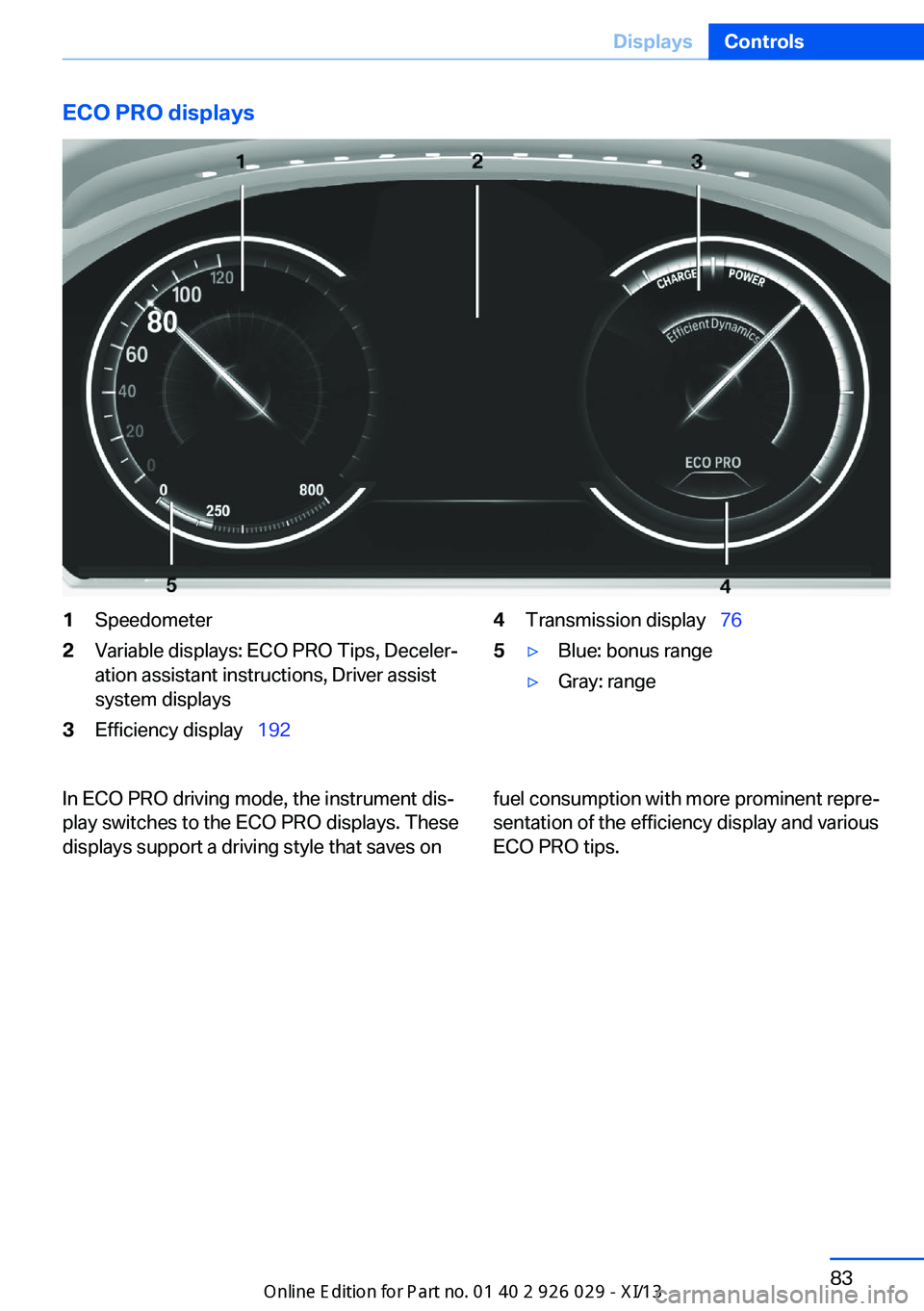
ECO PRO displays1Speedometer2Variable displays: ECO PRO Tips, Deceler‚Äź
ation assistant instructions, Driver assist
system displays3Efficiency display‚Äā‚ÄÖ 1924Transmission display‚Äā‚ÄÖ 765‚Ė∑Blue: bonus range‚Ė∑Gray: rangeIn ECO PRO driving mode, the instrument dis‚Äź
play switches to the ECO PRO displays. These
displays support a driving style that saves onfuel consumption with more prominent repre‚Äź
sentation of the efficiency display and various
ECO PRO tips.Seite 83DisplaysControls83
Online Edition for Part no. 01 40 2 911 177 - VI/13
Page 89 of 273
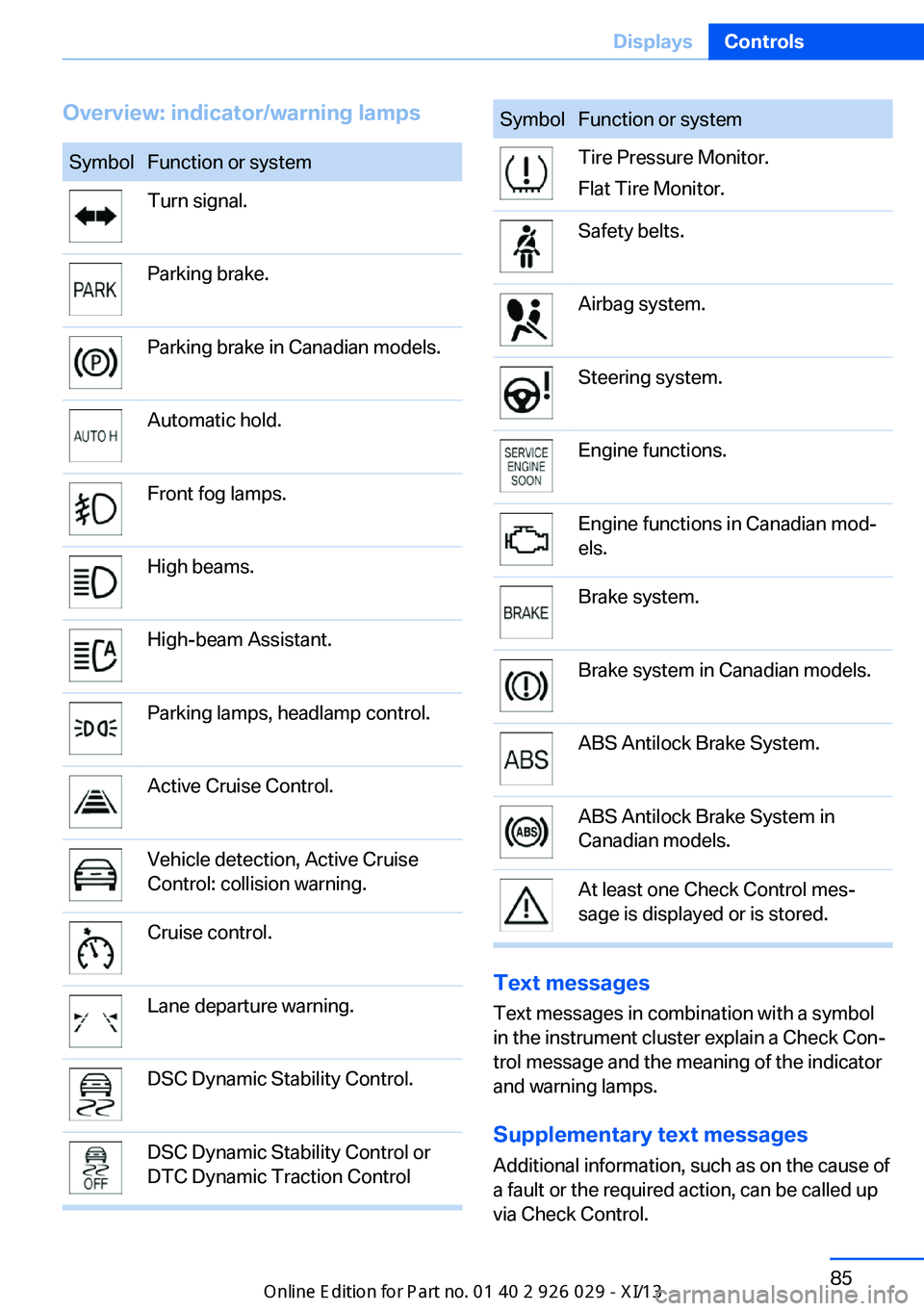
Overview: indicator/warning lampsSymbolFunction or systemTurn signal.Parking brake.Parking brake in Canadian models.Automatic hold.Front fog lamps.High beams.High-beam Assistant.Parking lamps, headlamp control.Active Cruise Control.Vehicle detection, Active Cruise
Control: collision warning.Cruise control.Lane departure warning.DSC Dynamic Stability Control.DSC Dynamic Stability Control or
DTC Dynamic Traction ControlSymbolFunction or systemTire Pressure Monitor.
Flat Tire Monitor.Safety belts.Airbag system.Steering system.Engine functions.Engine functions in Canadian mod‚Äź
els.Brake system.Brake system in Canadian models.ABS Antilock Brake System.ABS Antilock Brake System in
Canadian models.At least one Check Control mes‚Äź
sage is displayed or is stored.
Text messages
Text messages in combination with a symbol
in the instrument cluster explain a Check Con‚Äź trol message and the meaning of the indicator
and warning lamps.
Supplementary text messages
Additional information, such as on the cause of
a fault or the required action, can be called up
via Check Control.
Seite 85DisplaysControls85
Online Edition for Part no. 01 40 2 911 177 - VI/13
Page 100 of 273
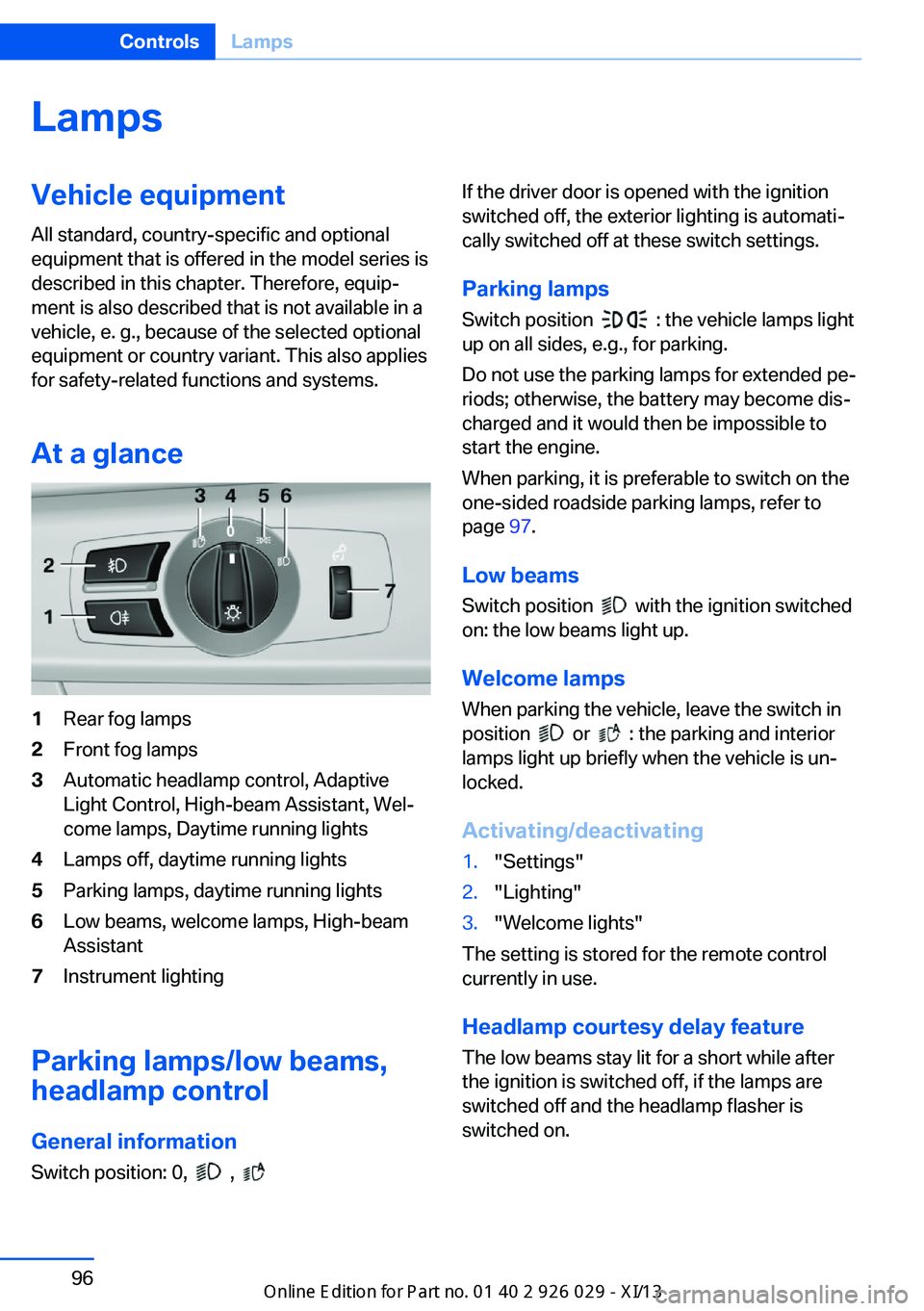
LampsVehicle equipment
All standard, country-specific and optional
equipment that is offered in the model series is
described in this chapter. Therefore, equip‚Äź
ment is also described that is not available in a
vehicle, e. g., because of the selected optional
equipment or country variant. This also applies
for safety-related functions and systems.
At a glance1Rear fog lamps2Front fog lamps3Automatic headlamp control, Adaptive
Light Control, High-beam Assistant, Wel‚Äź
come lamps, Daytime running lights4Lamps off, daytime running lights5Parking lamps, daytime running lights6Low beams, welcome lamps, High-beam
Assistant7Instrument lighting
Parking lamps/low beams,
headlamp control
General information Switch position: 0,
,
If the driver door is opened with the ignition
switched off, the exterior lighting is automati‚Äź
cally switched off at these switch settings.
Parking lamps
Switch position
: the vehicle lamps light
up on all sides, e.g., for parking.
Do not use the parking lamps for extended pe‚Äź
riods; otherwise, the battery may become dis‚Äź
charged and it would then be impossible to
start the engine.
When parking, it is preferable to switch on the
one-sided roadside parking lamps, refer to
page 97.
Low beams Switch position
with the ignition switched
on: the low beams light up.
Welcome lamps When parking the vehicle, leave the switch in
position
or : the parking and interior
lamps light up briefly when the vehicle is un‚Äź
locked.
Activating/deactivating
1."Settings"2."Lighting"3."Welcome lights"
The setting is stored for the remote control
currently in use.
Headlamp courtesy delay feature
The low beams stay lit for a short while after
the ignition is switched off, if the lamps are
switched off and the headlamp flasher is
switched on.
Seite 96ControlsLamps96
Online Edition for Part no. 01 40 2 911 177 - VI/13
Page 102 of 273
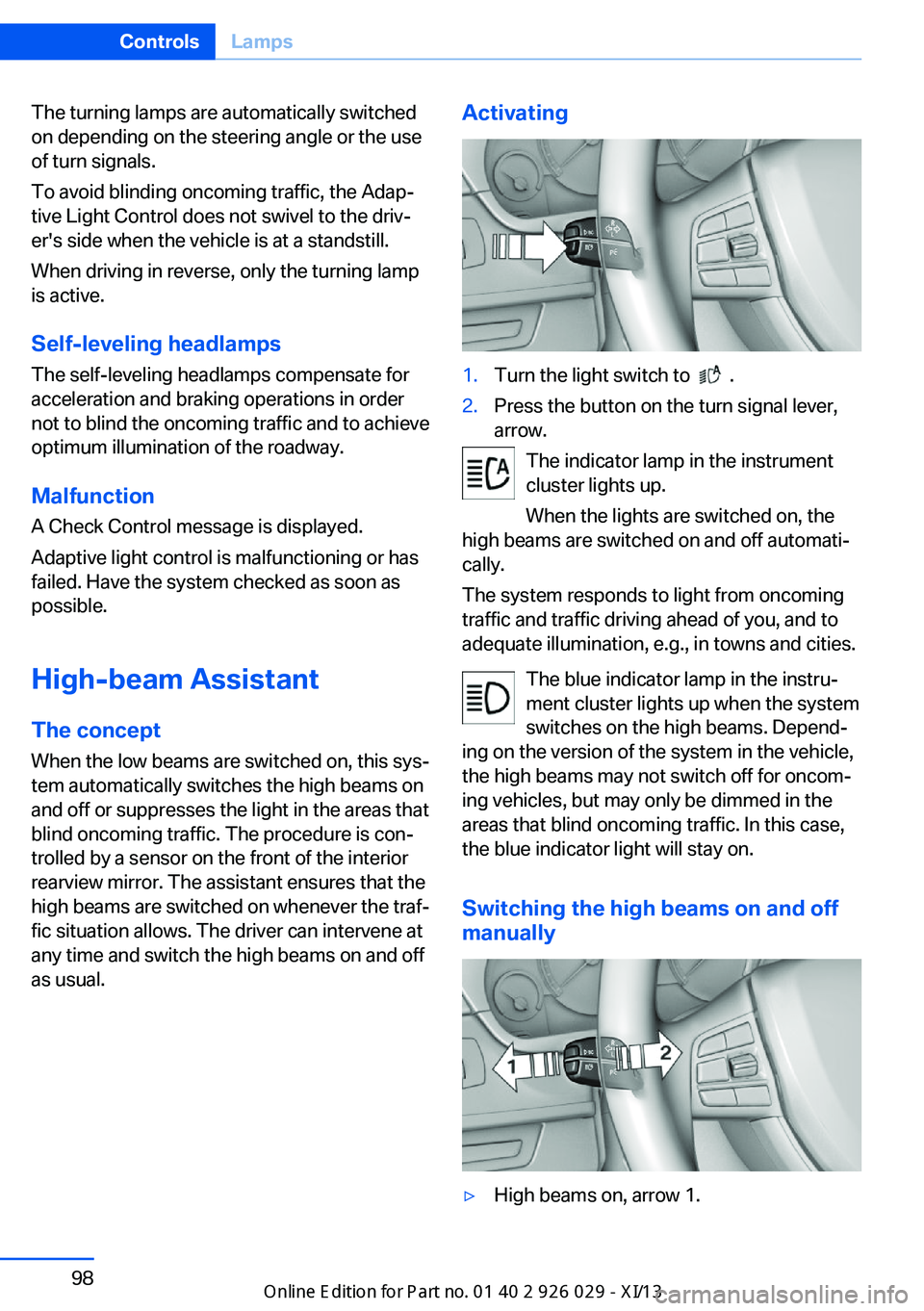
The turning lamps are automatically switched
on depending on the steering angle or the use
of turn signals.
To avoid blinding oncoming traffic, the Adap‚Äź
tive Light Control does not swivel to the driv‚Äź
er's side when the vehicle is at a standstill.
When driving in reverse, only the turning lamp
is active.
Self-leveling headlamps The self-leveling headlamps compensate for
acceleration and braking operations in order
not to blind the oncoming traffic and to achieve
optimum illumination of the roadway.
Malfunction
A Check Control message is displayed.
Adaptive light control is malfunctioning or has
failed. Have the system checked as soon as
possible.
High-beam Assistant
The concept When the low beams are switched on, this sys‚Äź
tem automatically switches the high beams on
and off or suppresses the light in the areas that
blind oncoming traffic. The procedure is con‚Äź
trolled by a sensor on the front of the interior
rearview mirror. The assistant ensures that the
high beams are switched on whenever the traf‚Äź
fic situation allows. The driver can intervene at
any time and switch the high beams on and off
as usual.Activating1.Turn the light switch to .2.Press the button on the turn signal lever,
arrow.
The indicator lamp in the instrument
cluster lights up.
When the lights are switched on, the
high beams are switched on and off automati‚Äź
cally.
The system responds to light from oncoming
traffic and traffic driving ahead of you, and to
adequate illumination, e.g., in towns and cities.
The blue indicator lamp in the instru‚Äź
ment cluster lights up when the system
switches on the high beams. Depend‚Äź
ing on the version of the system in the vehicle, the high beams may not switch off for oncom‚Äź
ing vehicles, but may only be dimmed in the
areas that blind oncoming traffic. In this case,
the blue indicator light will stay on.
Switching the high beams on and off
manually
‚Ė∑High beams on, arrow 1.Seite 98ControlsLamps98
Online Edition for Part no. 01 40 2 911 177 - VI/13
Page 103 of 273
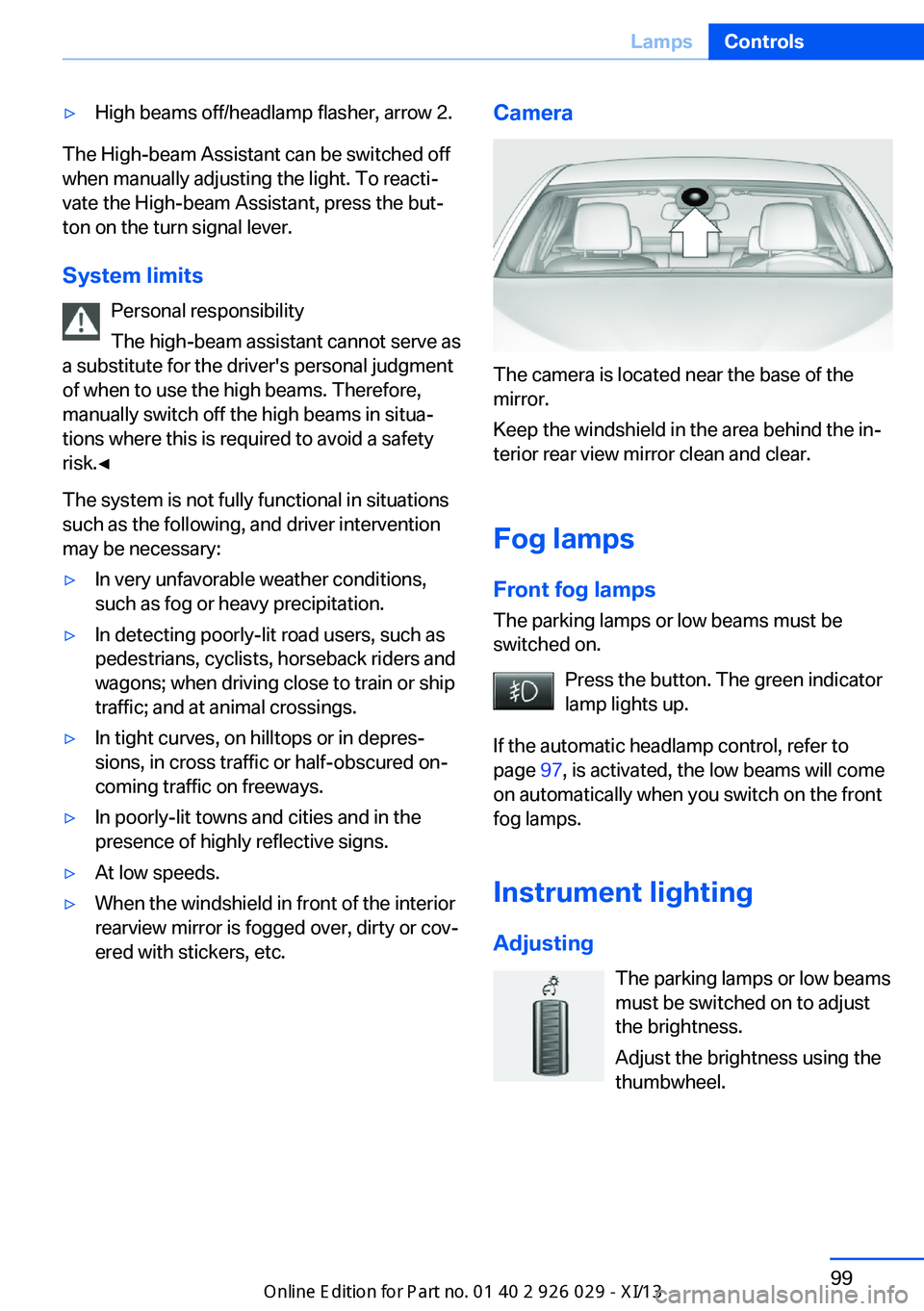
‚Ė∑High beams off/headlamp flasher, arrow 2.
The High-beam Assistant can be switched off
when manually adjusting the light. To reacti‚Äź
vate the High-beam Assistant, press the but‚Äź
ton on the turn signal lever.
System limits Personal responsibility
The high-beam assistant cannot serve as
a substitute for the driver's personal judgment
of when to use the high beams. Therefore,
manually switch off the high beams in situa‚Äź
tions where this is required to avoid a safety
risk.‚óÄ
The system is not fully functional in situations
such as the following, and driver intervention
may be necessary:
‚Ė∑In very unfavorable weather conditions,
such as fog or heavy precipitation.‚Ė∑In detecting poorly-lit road users, such as
pedestrians, cyclists, horseback riders and
wagons; when driving close to train or ship
traffic; and at animal crossings.‚Ė∑In tight curves, on hilltops or in depres‚Äź
sions, in cross traffic or half-obscured on‚Äź
coming traffic on freeways.‚Ė∑In poorly-lit towns and cities and in the
presence of highly reflective signs.‚Ė∑At low speeds.‚Ė∑When the windshield in front of the interior
rearview mirror is fogged over, dirty or cov‚Äź
ered with stickers, etc.Camera
The camera is located near the base of the
mirror.
Keep the windshield in the area behind the in‚Äź
terior rear view mirror clean and clear.
Fog lamps
Front fog lamps The parking lamps or low beams must be
switched on.
Press the button. The green indicator
lamp lights up.
If the automatic headlamp control, refer to
page 97, is activated, the low beams will come
on automatically when you switch on the front
fog lamps.
Instrument lighting Adjusting The parking lamps or low beams
must be switched on to adjust
the brightness.
Adjust the brightness using the
thumbwheel.
Seite 99LampsControls99
Online Edition for Part no. 01 40 2 911 177 - VI/13
Page 127 of 273
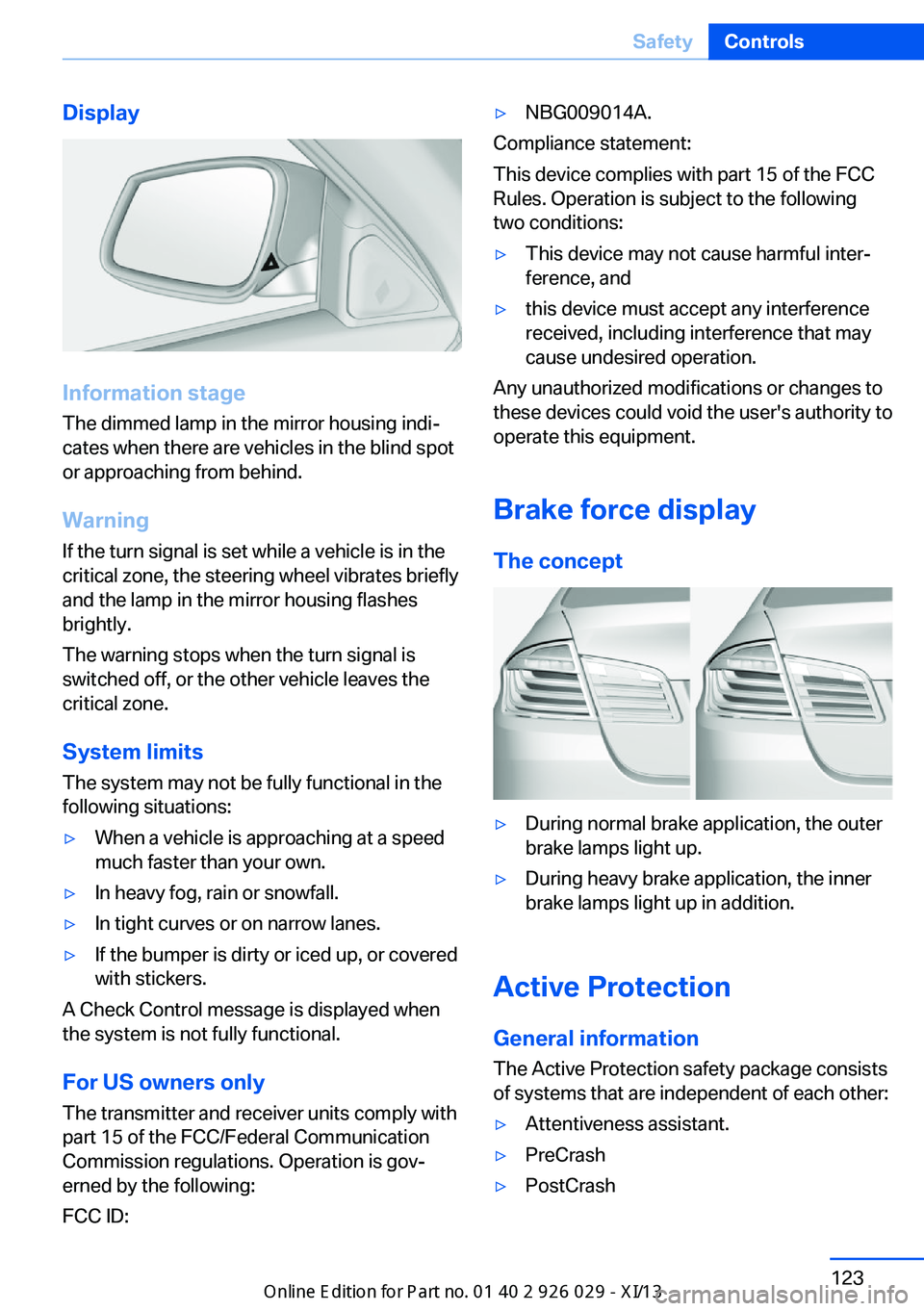
Display
Information stage
The dimmed lamp in the mirror housing indi‚Äź
cates when there are vehicles in the blind spot
or approaching from behind.
Warning
If the turn signal is set while a vehicle is in the
critical zone, the steering wheel vibrates briefly
and the lamp in the mirror housing flashes
brightly.
The warning stops when the turn signal is
switched off, or the other vehicle leaves the
critical zone.
System limits
The system may not be fully functional in the
following situations:
‚Ė∑When a vehicle is approaching at a speed
much faster than your own.‚Ė∑In heavy fog, rain or snowfall.‚Ė∑In tight curves or on narrow lanes.‚Ė∑If the bumper is dirty or iced up, or covered
with stickers.
A Check Control message is displayed when
the system is not fully functional.
For US owners only The transmitter and receiver units comply with
part 15 of the FCC/Federal Communication
Commission regulations. Operation is gov‚Äź
erned by the following:
FCC ID:
‚Ė∑NBG009014A.
Compliance statement:
This device complies with part 15 of the FCC
Rules. Operation is subject to the following
two conditions:
‚Ė∑This device may not cause harmful inter‚Äź
ference, and‚Ė∑this device must accept any interference
received, including interference that may
cause undesired operation.
Any unauthorized modifications or changes to
these devices could void the user's authority to
operate this equipment.
Brake force display
The concept
‚Ė∑During normal brake application, the outer
brake lamps light up.‚Ė∑During heavy brake application, the inner
brake lamps light up in addition.
Active Protection
General information
The Active Protection safety package consists
of systems that are independent of each other:
‚Ė∑Attentiveness assistant.‚Ė∑PreCrash‚Ė∑PostCrashSeite 123SafetyControls123
Online Edition for Part no. 01 40 2 911 177 - VI/13
Page 128 of 273
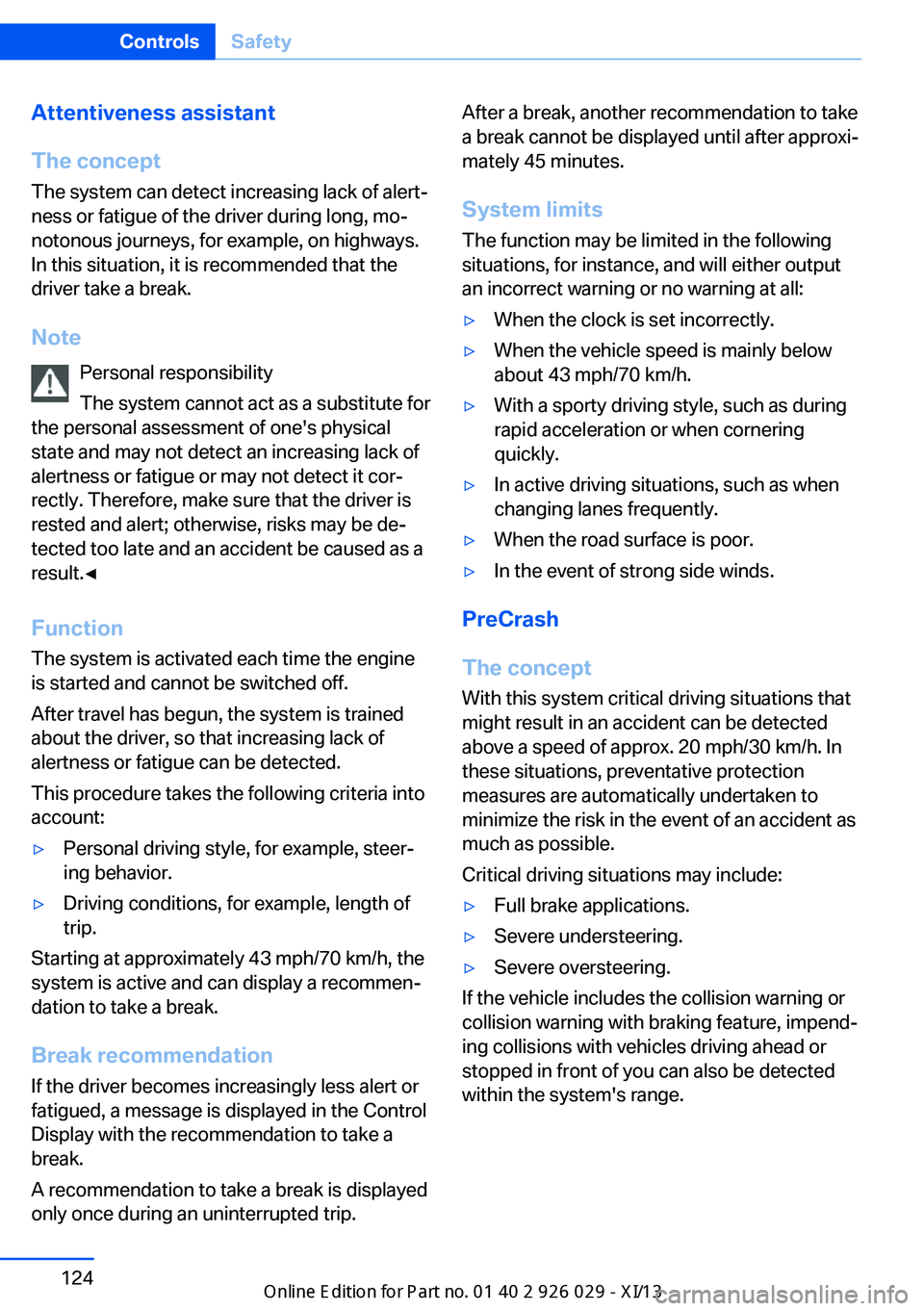
Attentiveness assistant
The concept The system can detect increasing lack of alert‚Äź
ness or fatigue of the driver during long, mo‚Äź
notonous journeys, for example, on highways.
In this situation, it is recommended that the
driver take a break.
Note Personal responsibility
The system cannot act as a substitute for
the personal assessment of one's physical
state and may not detect an increasing lack of
alertness or fatigue or may not detect it cor‚Äź
rectly. Therefore, make sure that the driver is
rested and alert; otherwise, risks may be de‚Äź
tected too late and an accident be caused as a
result.‚óÄ
Function
The system is activated each time the engine
is started and cannot be switched off.
After travel has begun, the system is trained
about the driver, so that increasing lack of
alertness or fatigue can be detected.
This procedure takes the following criteria into
account:‚Ė∑Personal driving style, for example, steer‚Äź
ing behavior.‚Ė∑Driving conditions, for example, length of
trip.
Starting at approximately 43 mph/70 km/h, the
system is active and can display a recommen‚Äź
dation to take a break.
Break recommendation
If the driver becomes increasingly less alert or
fatigued, a message is displayed in the Control
Display with the recommendation to take a
break.
A recommendation to take a break is displayed
only once during an uninterrupted trip.
After a break, another recommendation to take
a break cannot be displayed until after approxi‚Äź
mately 45 minutes.
System limits
The function may be limited in the following
situations, for instance, and will either output
an incorrect warning or no warning at all:‚Ė∑When the clock is set incorrectly.‚Ė∑When the vehicle speed is mainly below
about 43 mph/70 km/h.‚Ė∑With a sporty driving style, such as during
rapid acceleration or when cornering
quickly.‚Ė∑In active driving situations, such as when
changing lanes frequently.‚Ė∑When the road surface is poor.‚Ė∑In the event of strong side winds.
PreCrash
The concept With this system critical driving situations that
might result in an accident can be detected
above a speed of approx. 20 mph/30 km/h. In these situations, preventative protection
measures are automatically undertaken to
minimize the risk in the event of an accident as
much as possible.
Critical driving situations may include:
‚Ė∑Full brake applications.‚Ė∑Severe understeering.‚Ė∑Severe oversteering.
If the vehicle includes the collision warning or
collision warning with braking feature, impend‚Äź
ing collisions with vehicles driving ahead or
stopped in front of you can also be detected
within the system's range.
Seite 124ControlsSafety124
Online Edition for Part no. 01 40 2 911 177 - VI/13